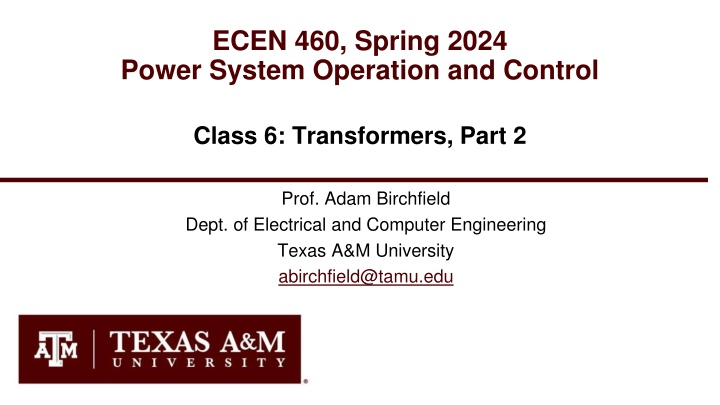
Power System Operation and Control: Transformers in Electrical Engineering
Dive into the complexities of transformers in power systems, covering topics like non-ideal transformer examples, per-unit analysis methodologies, and calculating reactance values. Understand the practical applications of transformer models and how to work with per-unit parameters effectively. Get ready to enhance your knowledge in transformer operation and control.
Download Presentation

Please find below an Image/Link to download the presentation.
The content on the website is provided AS IS for your information and personal use only. It may not be sold, licensed, or shared on other websites without obtaining consent from the author. If you encounter any issues during the download, it is possible that the publisher has removed the file from their server.
You are allowed to download the files provided on this website for personal or commercial use, subject to the condition that they are used lawfully. All files are the property of their respective owners.
The content on the website is provided AS IS for your information and personal use only. It may not be sold, licensed, or shared on other websites without obtaining consent from the author.
E N D
Presentation Transcript
ECEN 460, Spring 2024 Power System Operation and Control Class 6: Transformers, Part 2 Prof. Adam Birchfield Dept. of Electrical and Computer Engineering Texas A&M University abirchfield@tamu.edu
2 Homework 3 and 4 No homework on generators. Make sure you understand the lecture notes and labs 3 and 4 (starting next week). Homework 3 on transformers: book problems 3.4, 3.23, due Feb. 8th. Homework 4 on transmission lines: book regular problems 4.10, 4.11, 4.20, and 4.41, 5.14 (a,b), 5.38, and 5.41 (a,b), due Feb. 15th.
3 Non-Ideal Transformer Example Example: A single phase, 15 MVA, 35/13 kV transformer has the following test data: open circuit: 14 amps, with 3 kW losses short circuit: 6 kV, with 200 kW losses Determine the model parameters. n
4 Transformer Example, Cont d From the short circuit test ???=15??? 35?? Psc= ????? Hence Xe= 6 ?? 429 ?= 14 = 429 ?, Re+ ??? = 2= 500 kW Re= 1.09 , 142 12= 14 From the open circuit test ??=35 ??2 3 ?? Re+ ???+ ??? =35 ?? = 0.408 ? = 2500 ??= 2500 14 ?
5 Per Unit Change of MVA Base Parameters for equipment are often given using power rating of equipment as the MVA base To analyze a system all per unit data must be on a common power base ???????????? ??????? ??? ??????? ????? ????? ????? ????? ??? 2 2 ????? ????? ???????????? ??????? Hence Z?? ????????????/ ???????= ??? ??????? ????????????= ??? ???????????? ??????? Z??
6 Per Unit Change of Base Example A 54 MVA transformer has a leakage reactance of 3.69%. What is the reactance on a 100 MVA base? 100 54 = = 0.0369 0.0683 p.u. X e
7 Transformer Reactance Transformer reactance is often specified as a percentage, say 10%. This is a per unit value (divide by 100) on the power base of the transformer. Example: A 350 MVA, 230/20 kV transformer has leakage reactance of 10%. What is p.u. value on 100 MVA base? What is value in ohms (230 kV)? ??= 0.10 100 0.0286 2302 350= 0.0286 p.u. 100= 15.1
8 Three Phase Per-Unit Procedure is very similar to 1 phase except we use a 3 phase VA base, and use line to line voltage bases Pick a 3? VA base for the entire system Pick a voltage base for each different voltage level, ??. Voltages are line to line. Calculate the impedance base S 3 B 2 2 2 ( 3 ) B LL V S B LN V S B LN V S , 3 B , B , = = = Z B 1 1 B 3 Exactly the same impedance bases as with single phase!
9 Three Phase Per-Unit, Cont'd Calculate the current base, ?? 3 B 1 B V 1 B 3 S S S 3 B 1 B = = = = I I 3 B LL V 3 3 B LN V , , , B LN Exactly the same current bases as with single phase! But, be careful in using 3ph bases to calculate it (need a root 3) Convert actual values to per unit
10 Three Phase Per-Unit Example Solve for the current, load voltage and load power in the previous circuit, assuming a 3? power base of 300 MVA, and line to line voltage bases of 13.8 kV,138 kV and 27.6 kV (square root of 3 larger than the 1f example voltages). Also assume the generator is Y-connected so its line to line voltage is 13.8 kV. Convert to per unit as before. Note the system is exactly the same!
11 3? Per-Unit Example, Cont'd 1.0 0 3.91+?2.327= 0.22 30.8 p.u. (not amps) VL = 1.0 0 0.22 30.8 2.327 90 = 0.859 30.8 p.u. ?? ? ?? = 1.0 0 0.22 30.8 = 0.22 30.8 p.u. ? = 2 = = 0.189 p.u. ??= ???? Again, analysis is exactly the same!
12 3? Per-Unit Example, Cont'd Differences appear when we convert back to actual values ?LActual= 0.859 30.8 27.6 kV = 23.8 30.8 kV ?LActual= 0.189 0 300 MVA = 56.7 0 MVA ?GActual= 0.22 30.8 300 MVA = 66.0 30.8 MVA IBMiddle = 3 138 kV= 1250 Amps (same current!) IMiddle 300 MVA Actual = 0.22 30.8 1250 Amps = 275 30.8
13 3? Per-Unit Example 2 Assume a 3? load of 100+j50 MVA with ??? of 69 kV is connected to a source through the below network: What is the supply current and complex power? Answer: I=467 amps, S = 103.3 + j76.0 MVA
